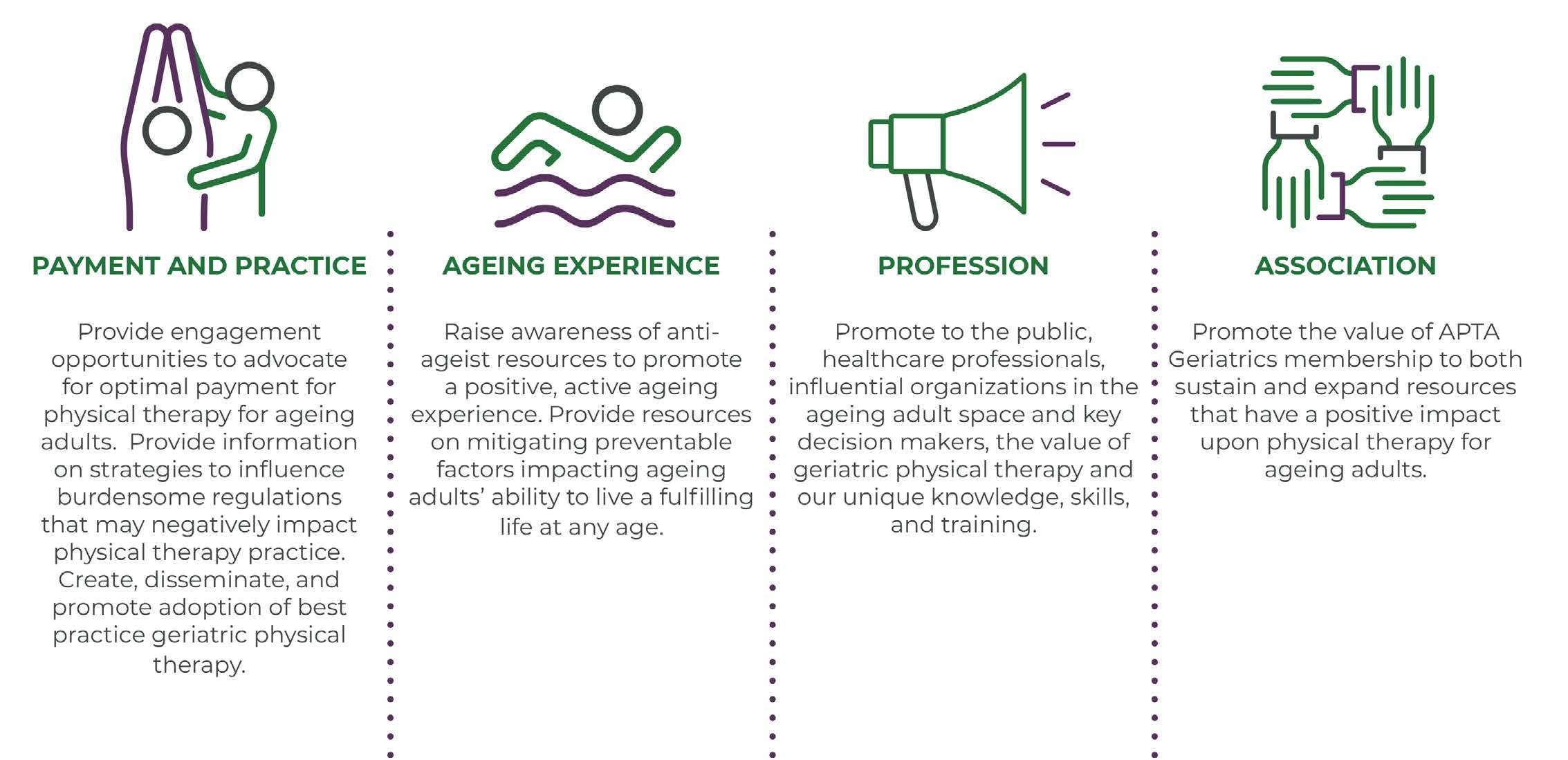
4 minute read
What is Advocacy?
by Ellen R. Strunk PT, MS
Advocacy is generally defined as the act or process of supporting a cause or proposal. Advocacy is the process to get to a policy decision. The advocacy process is cyclical and continuous because it depends on the goal. The goal may be a particular policy decision or to raise awareness of a particular subject. Advocacy is often fluid because it links to shifting priorities for both the advocate and the decision maker. The desired outcome of the advocacy process for geriatric physical therapists is often to heighten awareness of the profession, awareness of the experience of ageing, and to influence policy decisions that determine how a health care professional is allowed to practice. Advocacy plays a key role in building strong health systems and/or strong organizations. It gives people a voice in decisions that affect their lives and/or the future of an organization’s path.
Advertisement
To effectively advocate for changes that match a desired outcome, a systematic plan of action is required. One approach is outlined in the 6-step advocacy framework in Figure 1.
First the issue(s) is identified. This step is important because it defines the objective(s). The ability to clearly articulate the issue(s) is key to gaining support.
Next is gathering information to support the need for change. Gathering wide-spread information, Step 2, is also essential to understanding the scope and breadth of the issue(s). Research may be necessary to provide potential solutions to a problem or to increase support for
Figure 1 a change from a current practice.
The third step is to establish priorities: What are the goals for an advocacy plan?
Strategies for achieving the goals of the advocacy plan become Step 4. Much like carefully selecting treatment interventions or appropriate dose of exercise in a physical therapy plan of care, strategies should be targeted and effective. Finding alliances with others who share a common interest and passion for a particular policy or issue can multiply the efforts of one person or organization.
Step five is to build support and engage others in the process to build momentum.
Assess and evaluate is the last step in this advocacy process. Even when a goal is achieved, advocacy is never "final" because there is always the need to evaluate whether the goal was truly met. The process of analyzing efficacy also helps to inform the next round of advocacy.
In its 2021-2023 Strategic Plan, APTA Geriatrics identified Advocacy as one of its 3 primary goals. The Board of Directors identified the key issue: there needs to be an increased awareness of geriatric physical therapy. A workgroup was assembled to gather information and explore which areas and issues APTA Geriatrics should be advocating in/for as well as where our collective voice could be most effective. Following on to the third step, priorities were established. These are illustrated in Figure 2.
The fourth step will be to outline strategies. For example, health policy and advocacy are interwoven because policy decisions determine how health care professionals practice. Potential strategies identified by the workgroup in the area of payment and practice include the following: • Transfer information to members in every state so each has the information needed to advocate at the
Figure 2

local level, including in their organizations, their community, their state government and at the federal level. • Disseminate best practices to increase the value of physical therapy. • Advocate with select committees, such as the positive role(s) physical therapists have in the nation’s nursing homes to the Senate Finance committee; the impact physical therapy can have in preventing falls to the
Senate Special Committee on Ageing. • Advance the involvement of APTA Geriatrics members in policy development for the Unified Post-Acute Care (UPAC) Payment system.
This is certainly not an exhaustive list; the Academy is looking forward to getting additional ideas from the membership, not only in the area of payment and practice, but in all 4 advocacy areas (see below).
Policy and advocacy go hand in hand. To enact or change policy takes a concerted effort to influence the bodies that possess the power to make these changes. It is essential, regardless of practice setting, political perspective, or policy expertise, that physical therapists engage in the health policy and advocacy process. Advocacy is part of our professional responsibility to further the profession’s ability to serve patients and help them reach their full potential.
Ellen R. Strunk is President and Owner of Rehab Resources & Consulting, Inc., a company providing consulting services and training to providers in postacute care settings with a focus on helping customers understand the CMS prospective payment systems. She also lectures nationally on the topics of pharmacology for rehabilitation professionals, exercise and wellness for older adults, and coding/ billing/ documentation to meet medical necessity guidelines and payer regulations.
APTA-Geriatrics advocates for the following:








